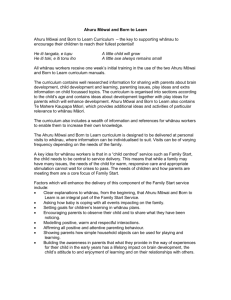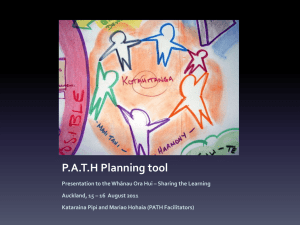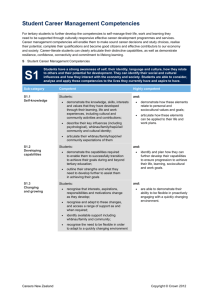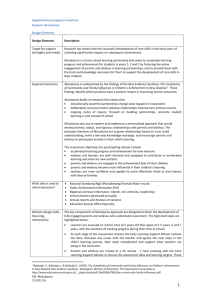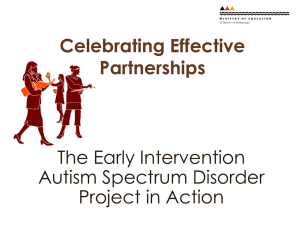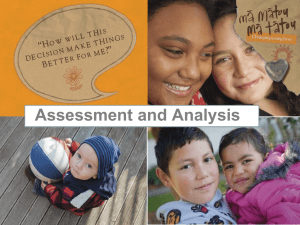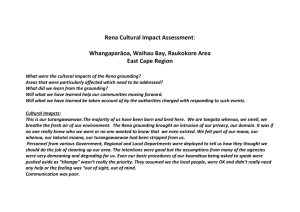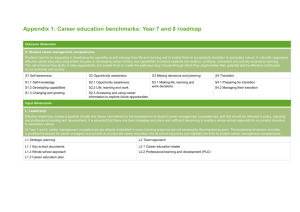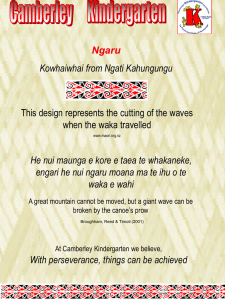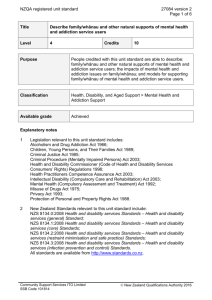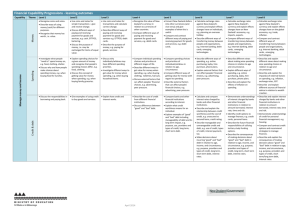What is transition? - Ministry of Education
advertisement
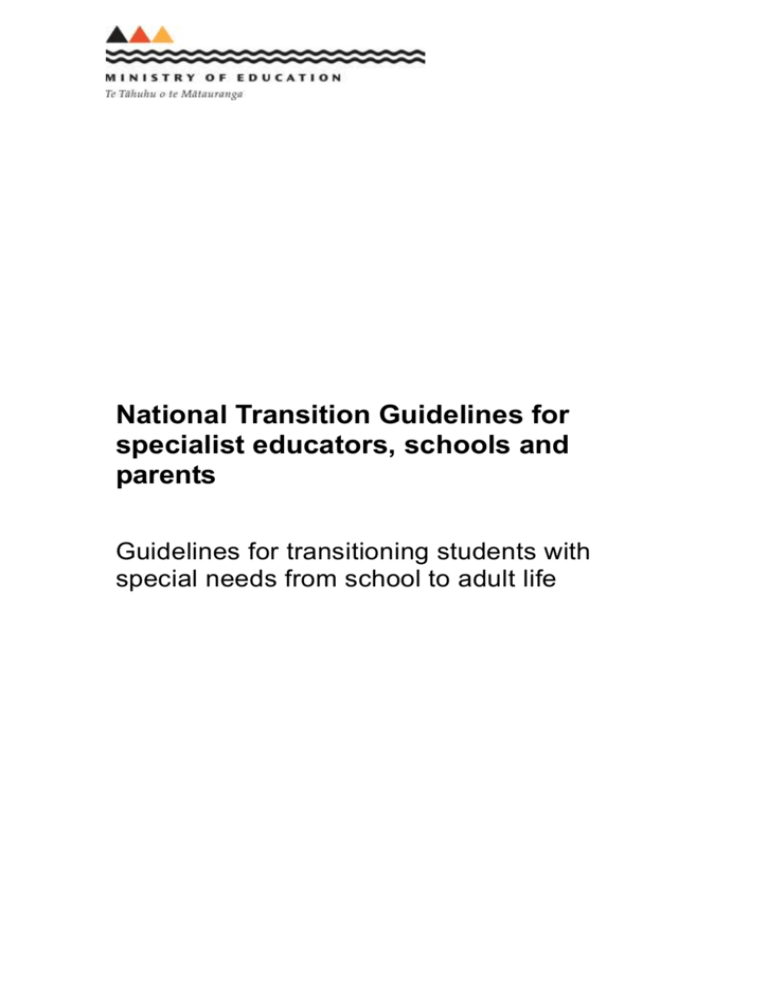
National Transition Guidelines for specialist educators, schools and parents Guidelines for transitioning students with special needs from school to adult life Why a good transition matters We make many transitions in our lives but one of the most critical is our move from school into adulthood. For some students, particularly those with significant learning and social needs, the transition from school is probably the most crucial process for determining how the rest of their lives will unfold. Those supporting young people as they leave school have an obligation to ‘get it right’ and follow best practice. This includes: allowing the young person to direct the process involving parents, families and whānau providing information on post-school options transitioning being a coordinated and recognised process with schools, parents, students and agencies working in partnership. Purpose of these guidelines These guidelines provide schools, special education specialists and other professionals with best practice information to ensure effective transition support is put in place for children with special education needs. What has informed these guidelines These guidelines have been informed by New Zealand and International Best Practice evidence. They take account of the New Zealand Disability Strategy 2001 and the Administrative Guidelines for Education – National Administration Guidelines (NAGs), specifically 1.6. What is transition? A Transition is a process, not a one off event. During transition an individual student receives support, through planning, to identify and achieve – or move closer – to their career and lifestyle aspirations. This planning is detailed in an Individual Career Plan or ICP. ICPs cover employment and financial independence, community participation, home and living arrangements, independent mobility, peer relationships, sexuality and self-esteem. March 2011 Page 2 of 8 The 10 best practice principles There are 10 best practice principles that underpin successful transitions. They are supported by recent New Zealand research and international best evidence. These are summarised below and then translated into action points for educators. 1. The transition from school process starts when the student turns 14 at the latest. It is part of a specific planning process that aims to maximise academic achievement as well as functional life skills. 2. The student and their family/whānau drive the process. 3. Partnerships are developed between the school and community supports. 4. The transition plan is embedded in mainstream education and community settings. 5. The process identifies and overcomes barriers to the student’s learning and support. 6. The student and family/whānau are offered information and support that opens the door to a wide range of inclusive community-based options. 7. There is a clear distinction between the needs of the family/whānau and the needs of the student during transition. 8. Develop and practise functional life skills at home and in other natural settings. 9. From the age of 18 students with special needs should receive services in natural community settings. 10. Regularly evaluate the outcomes of the transition planning process. 1. The transition from school process starts when the student turns 14 at the latest. It is part of a specific planning process that aims to maximise academic achievement as well as functional life skills. What does this mean for education staff working with the student? An integral part of the New Zealand Curriculum involves getting students to think about growing up, looking to their future, and managing themselves and their time. Future-focused education prepares students and their families/whānau for transition points throughout their schooling and for life after school. Action points: Set up conversations about adult life at the start of secondary school and weave these into everyday learning. Ensure a consistent transition process is underway from at least the age of 14 that involves the student, school and family/whānau. March 2011 Page 3 of 8 During the individual planning process have regular conversations with the student about future transitions. Focus support on eliminating barriers to learning. Set goals and make sure both the student and their family/whānau get a sense of progress over time. Offer professional development for school staff on the transition process. Identify networking opportunities for schools to share and develop aspects of their transition process. If teachers’ aides are used as job coaches, provide them with training. This should cover topics such as visual schedules for work tasks, social skills, workplace ethics and solutions for developing independence. Incorporate transition goals from at least the age of 14 into planning that develops the student’s academic potential and functional skills. Develop a plan to link the student into the community through private and public organisations. Develop fact sheets that outline the steps in the transition process so that everyone involved has a clear picture of what will happen and when, as well as the part they need to play in this process. 2. The student and their family/whānau drive the process. What does this mean for education staff working with the student? Transition covers everything that helps meet the aspirations of the student. The student and their family/whānau should be encouraged to become actively involved in planning the transition process and determining future goals. Action points: Involve the student in setting the agenda and work out the most effective communication style for getting them actively involved in their transition planning. Identify the student’s strengths and challenges early in the process. Support the student to prepare for transition meetings. For example, develop visual material and pre-teach main points. Work with the student and family/whānau to develop and agree on their roles and responsibilities. Teach decision-making skills from an early age and provide the student with opportunities to make meaningful, real-life decisions. Obtain informed agreement from the student throughout the process. March 2011 Page 4 of 8 3. Partnerships are developed between the school and community supports. What does this mean for education staff working with the student? Schools, Special Education staff and students should work collaboratively with tertiary institutions and community employers to develop tertiary study and other post-school options for future employment and community participation. Action points: Identify and work to overcome any barriers to creating pathways to tertiary study, future employment and community participation. Develop a shared understanding with all involved about what constitutes successful transition. Build and maintain collaborative community and agency partnerships. Make sure there is access to Ministry of Education resources such as Gateway, STAR, Youth Guarantee and Careers advice. Find out what community and government-funded support is available locally. Identify tertiary level courses and community based programmes. Ensure a portfolio is put together in the final two years of school which records all the skills the student has developed. 4. The transition plan is embedded in mainstream education and community settings. What does this mean for education staff working with the student? Schools need to systematically develop ways for the student to acquire the New Zealand Curriculum key competencies in order to increase their ability to find employment and participate socially. Curriculum planning and delivery reflects all domains of adult life: vocational, life skills, social, academic and leisure skills. Schools are primarily responsible for increasing the student’s skills for life after school. They hold primary responsibility for the student’s academic achievements, functional skills, involvement in leisure and recreation activities, community involvement and work placement. Action points: Collaborate with the student to ensure their programme aligns with their aspirations and meets their needs in terms of their life-long development. Base the student’s skills development around their aspirations and choices for how they will spend their future. March 2011 Page 5 of 8 Focus on increasing the student’s academic achievements and functional skills in an appropriate and natural setting. 5. The process identifies and overcomes barriers to the student’s learning and support. What does this mean for education staff working with the student? The key to a successful transition lies in good planning and starting the process early. Schools need to find out what the student’s hopes and dreams are during their first two years of secondary school, then plan to provide the academic and functional skills the student will need in moving to realise their aspirations. Action plan: Regularly evaluate the student’s written plan to assess their progress and to identify any barriers that need to be addressed. Consider creating a specialist transition position through innovative use of school funding. This position could fulfil a liaison, information and advocacy function for a single school or a cluster of schools. 6. The student and family/whānau are offered information and support that opens the door to a wide range of inclusive community-based options. What does this mean for education staff working with the student? Lack of information is one of the greatest barriers to successful transition. School staff with comprehensive, up-to-date knowledge of community support options can be valuable conduits of information for the student and their family/whānau. Areas where staff could consider developing their knowledge of communitybased support options include: supported living, employment, community participation, disability support, transport and further study options. Action plan: Look for district-specific publications that provide local information on transition options, vocational training and support services i.e. Exploring Futures. Work with the student and their family/whānau to identify the full range of options available. Work with the student during the planning process to outline their preferred options. Provide them with information and support that will enable them to make sound decisions around these options. March 2011 Page 6 of 8 Encourage disability support agencies to be actively involved in providing information. 7. There is a clear distinction between the needs of the family/whānau and the needs of the student during transition. What does this mean for education staff working with the student? The main aim of transition is to realise the hopes and dreams of the student. This has to fit within the hopes, dreams and capacity of the family/whānau, some members of which often have their own fears and expectations that will need to be considered, addressed and, in some situations, challenged. Action points: Acknowledge that the family/whānau have their own support needs and ensure they can access support and information. Provide the family/whānau with processes and information that will help them to create a positive vision of their child’s future. Take into account during all planning that there will be a natural expectation from both the student and the family/whānau of increased independence as the student moves into adulthood. 8. Develop and practise functional life skills at home and in other natural settings What does this mean for education staff working with the student? Schools should provide support and information to family/whānau and community groups so they can help the student apply and build on the skills they’re learning at school. Skills related to work, recreation and leisure should be practised in community settings. Action points: Use ICP goals to ensure the student is taught functional life skills in a way that is general enough for them to be able to apply them in home and community settings. Tailor ICP goals to meet precise skill needs of the student in a community setting wherever necessary. Set functional skills goals from the age of 14 at the latest, preferably earlier. March 2011 Page 7 of 8 9. From the age of 18 students with special needs should receive services in natural community settings. What does this mean for education staff working with the student? Schools and support people work towards integrating students with special needs into the settings they are likely to be in once they leave school. This may include work experience, integration into tertiary study, part-time employment, supported employment, recreation and leisure activities. Action points: Schools and disability support agencies should take a lead role in actively seeking opportunities for the student to take part in activities in their local community, such as using the library, swimming pool, gym, local businesses and joining clubs. Encourage the student to transition from school at the same age as their peers. 10. Regularly evaluate the outcomes of the transition planning process. What does this mean for education staff working with the student? Schools need to evaluate their transition programmes to measure how effective the process is. Action plan: Develop a range of indicators to measure the effectiveness of the transition process, such as using NCEA targets to measure success. Evaluate the outcomes for a group of students to determine what is working and what needs to change. Monitor students for six to 12 months after they leave school to inform the outcomes. Seek and acknowledge feedback from all parties. Use appropriate feedback from students to continually improve the transition process. March 2011 Page 8 of 8
